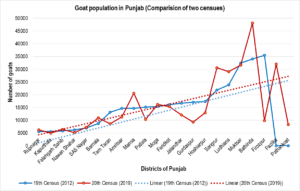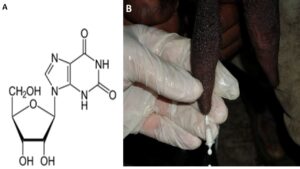Status of Goat Rearing in Punjab and Goat as a Model of Lactation Research
Ratan K Choudhary1* and Yadvi1
1College of Animal Biotechnology, Guru Angad Dev Veterinary and Animal Sciences University, Ludhiana, Punjab
*Corresponding author’s email: vetdrrkc@gmail.com
Abstract
Backyard farming of goats in India is common. Nowadays, commercial goat farming is becoming popular. In the last 20 years, the goat population in Punjab has been increasing. Goat rearing is meant for meat, milk, and fiber product and as a translational large animal model for stem cell research. This popular article deals with the status of the goat population in Punjab and introduces lactation research on Beetal goats at the University.
Keywords – Goat, Population, Punjab, Lactation research
The goat is a multi-functional animal and is reared for milk and meat in India. Goats play an essential role in the nutrition and economy of small farmers in our country. The rearing of goats is mainly practiced in rural areas. In a recent study, it has been noticed that goat milk drinks more as compared to cow milk. Thus, India occupies the first position in milk production. Not only milk but goat meat is also widely consumed in India. Chevon (Goat meat) is more consumed as compared to beef (cow meat) and carabeef (buffalo meat). According to WHO, 70% of people worldwide have allergies to cow milk. All over India, the goat is used for milk and meat production, although goat hair and skin are also used.
Goat population
In 2018, there were ~ 535.78 million goats worldwide and 135.17 million population in our country. In 2017, 2017.7 million herds were estimated for dairy goat farming. Goat milk is freshly consumed worldwide, mainly in Asia (52%) and Africa (39%) in Europe, America, and Oceania. India is the largest milk producer, with 20.17 % globally, with which goats contribute 4% of milk in India and 13.74% of meat in India. The highest goat population is in Rajasthan, and the most increased goat meat production is in West Bengal. As per the 19th livestock census of the Government of India, Punjab has a total of 3.27 lakh goat population, which will increase by 5.93% in the next five years. The total goat population in the 20th census conducted in 2019 was 3.479 lakhs. The goat population distribution in various Punjab districts with the highest number in Firozpur, followed by Bathinda, Muktsar, and Ludhiana (Figure 1).
India ranks top in the goat population with 26 registered breeds of goats, among which 12 are of high genetic merit. These 12 breeds of indigenous goats have a population of 45.5 million out of 135.17 million. Some indigenous breeds are Sirohi, Marwari, Beetal, Barbari, Surti, Kutchi, Berardi, Zawadi, Mehsana, Jamnapari, Jhakran, and Black Bengal.

Figure 1: District-wise goat population in Punjab of 19th and 20th census of Govt. of India. Trend lines (dotted lines) showed in the current 20th livestock census, the number of goats has increased by about 5.93% compared to the last 19th census. Bathinda district has the highest goat population in the 20th census.
Advantages of goat rearing
Goat farming has a broad economic range, and poor people can easily rear goats. Due to the low rearing rate, they play an essential role in providing livelihood to many low-income families in rural areas. Investment in goat farming is less as well as Management of the goat is easy due to its small body size and docile nature. Due to lower input requirements, goat rearing suits for unemployed youth, women, and ex-servicemen highly; goats are amiable animals and enjoy spending time with people. Goat farming has a role in entrepreneurship all over the world. Goats have social, economic, and biological advantages. Herds of dairy goats are an essential source of income. Goats are the ideal breed for mixed grazing. Goat breeds are raised for milk, meat, fiber, and cheese production. Both male and female goats have equal value. They are crucial in providing livelihood and income to the millions of low-income families in rural areas. Goat milk is easy to digest compared to cow or buffalo milk due to its small fat globule, and thus it is easily homogenized. Goat milk also plays a vital role in improving appetite and digestive efficiency. Goat milk has antifungal and antibacterial properties. Hence, its milk is used for treating various diseases like dengue fever. Goat meat is a low-energy diet as it has low cholesterol. There is no religious taboo against goat slaughter and meat consumption. The economic value of goats is 2.5 times more than the sheep on free-range grazing. Goat milk is greatly interested in society due to its increasing medicinal properties as a therapeutic health food nutraceutical and good for human health.
GADVASU’s initiatives on Beetal goat rearing and lactation research
Goat breeds that are found in Punjab are, Beetal or popularly called Amritsari. Beetal is a dual-purpose goat and is reared for milk and meat production. In general, a female Beetal goat produces 150-200 Kg of milk during the entire lactation period, which is six months. The average peak milk yield is about 2 Kg, and some exceptionally high-yielding goats may produce up to 4 Kg of milk per day.
Guru Angad Dev Veterinary and Animal Sciences University (GADVASU) maintains, genetically improves, and conducts research on Beetal goats. Initiatives to conserve and propagate Beetal goats by the University are manifested by establishing the Beetal flock at Ludhiana on the main campus of the University and the Regional Research and Training Centre in Kaljharani (district Bathinda) and in Talwara (district Hoshiarpur).
GADVASU’s initiatives on Beetal goat rearing and lactation research
Dairy goats have been used widely in lactation research. This is due to a smaller size, extensive availability, ease of handling, economic consideration, and a large number of animals that can be studied in a group, as well as similarity to cow and buffalo as ruminant species. In addition, the size of the goat and its organs is more convenient for handling in various surgical procedures like mammary tissue biopsy and suturing after surgical operations. Whole animal experiments can be conducted with ease. GADVASU researched the manipulation of a mammary stem cell population using xanthosine infusion into the teat canal (Figure 2). Xanthosine is a purine nucleotide that has been shown to increase mammary stem cells. This project aimed to evaluate the effects of xanthosine infusion on milk production in Beetal goat.

Figure 2: Xanthosine and goat study evaluating its effects on milk production and mammary stem cells. A) Structure of xanthosine, B) Xanthosine infusion after removing residual milk from one of the quarters of the Beetal goat mammary gland.
Xanthosine is hypothesized to increase stem cell number by promoting symmetrical cell division (Choudhary and Capuco 2012; Sherley 2013). Mammary stem/progenitor cells are essential for gland growth and tissue repair. This study aimed to evaluate transcriptomic changes in the lactating mammary gland infused with xanthosine. Expression of stem cell markers, namely aldehyde dehydrogenase enzymes (ALDH1A1, ALDH3B1), were upregulated in the xanthosine-treated gland (Choudhary, Choudhary, and Verma 2018). This study also examined xanthosine’s effects on the milk production of dairy goats as model animals for cows and buffalo. Gene expression analysis of milk synthesis genes, mammary stem/progenitor cell markers, cell proliferation, and differentiation markers were performed using real-time quantitative PCR (RT-qPCR). Results showed the transcripts of milk protein genes (BLG4, CSN2, LALBA, FABP3, CD36) and mammary stem/progenitor cell markers (ALDH1 and NR5A2) were increased as a result of xanthosine treatment. Average milk yield in TRT glands was increased marginally (approximately ~2% P = 0·05, paired t-test) per gland until seven weeks. Analysis of milk composition revealed that protein, lactose, fat, and solids-not-fat percentages remained the same and did not alter in composition. Our study suggested that xanthosine increases the expression of milk synthesis genes and mammary stem/progenitor cells, ultimately increasing milk production in animals (Choudhary, Choudhary, Pathak, et al., 2018).
A similar study in the goat and cow are warranted to validate the effects of xanthosine in increasing milk production.
Conclusion
The population of goats in Punjab has been increasing, probably due to the increased consumption of milk and meat. The goat provides wholesome food and fiber to humankind and serves as a large animal model for lactational research.
References
Choudhary RK, Capuco A V (2012) In vitro expansion of the mammary stem/progenitor cell population by xanthosine treatment. BMC Cell Biology 13, 14. doi:10.1186/1471-2121-13-14.
Choudhary RK, Choudhary S, Pathak D, Udehiya R, Verma R, Kaswan S, Sharma A, Gupta D, Honparkhe M, Capuco A V (2018) Evaluation of xanthosine treatment on gene expression of mammary glands in early lactating goats. Journal of Dairy Research 85, 288–294. doi:10.1017/S0022029918000493.
Choudhary RK, Choudhary S, Verma R (2018) In vivo response of xanthosine on mammary gene expression of lactating Beetal goat. Molecular Biology Reports 45, 581–590. doi:10.1007/s11033-018-4196-6.
Sherley JL (2013) Ex vivo expansion of human adult pancreatic cells with properties of distributed stem cells by suppression of asymmetric cell kinetics. Journal of Stem Cell Research & Therapy 03, 149. doi:10.4172/2157-7633.1000149.

